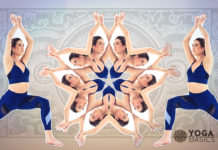Yoga is traditionally associated with only one goal—to attain samadhi or enlightenment. Yet householder yogis find it helpful and beneficial to pursue smaller and easier attainable goals. Yoga goals can be quite diverse, depending on if the focus on yoga’s physical, mental, emotional, or spiritual benefits. Having clear and specific yogic goals can help deepen one’s practice, improve your health, and help you live a life of greater balance, peace, and happiness. If you are looking to expand or deepen your yoga practice, you should consider using one or more yoga goals to lead the way.
Rigid vs Flexible Goals
Rigid goals have a very specific outcome and timeframe in mind. For example, if you want to lose weight, then losing 10 pounds in 60 days would be considered a rigid goal. A flexible goal, on the other hand, is more open-ended and general. It may be something like “I am going to eat healthy foods and take care of myself physically.”
Flexible goals allow you to make slow and small changes in your lifestyle without having to completely overhaul your entire way of living. There are a few downsides to flexible goals. One downside is that they aren’t as motivating because there isn’t a deadline for when you need to reach them. Another downside is that flexible goals don’t give you any immediate feedback about whether or not you are making progress towards reaching your long-term goals. This means that you could spend months working towards a flexible goal and never know if you are actually accomplishing anything.
In order to get the most out of your yoga session, try to incorporate both rigid and flexible goals into your daily routine. Use flexible goals to give you the big picture of what you want to achieve and to help you stay motivated and encouraged. Then use one or more detailed rigid goals with set deadlines to encourage consistent practice to move toward accomplishing your flexible goal.
Yoga goals to expand and deepen your yoga practice
Whether you’re new to yoga or already practicing, taking on one or more of these goals will guide you to improve your practice. For any of the items on this list that you’d like to explore, think about creating both flexible and rigid goals to use. Create and write down a detailed plan to achieve your goals with as many small steps as you can think of.
Increase your flexibility
Many people take up yoga to improve their flexibility and range of motion. Even experienced yogis work on improving flexibility to advance in the practice and be able to perform more challenging asanas. If your goal is to increase your flexibility, then focus on stretching poses that target the major muscle groups that are tightest in your body. Generally, you will want to focus more on seated and floor poses since they allow you to hold the position for a longer time. Yin and gentle yoga classes will focus more on flexibility than other styles. Don’t push, pull or force your way into the stretch—instead, work on relaxing into it.
Improve strength and build endurance
If your goal is to increase strength, then focus on holding poses that activate the muscles you wish to strengthen. If you want to build upper body strength, then incorporate long holds of Downward Facing Dog, Plank Pose, Cobra, Dolphin, Side Plank and arm balances like Crow Pose. If you want to develop lower body strength, then focus on standing poses such as Tree Pose, Mountain, the 5 Warrior Poses, Chair, and Goddess pose. If you want to develop your core, you can include exercises like Low Plank, Bridge, and Boat. Focus on breathing deeply during each pose and slowly building up to holding the pose for longer periods of time.
As you strengthen your muscles, you build endurance. Endurance refers to how long you can hold a position. Endurance is important as it helps you recover faster after intense workouts. Yoga builds endurance so you can hold the postures with ease and feel great after class.
Get stronger bones
Yoga has been shown to reduce stress fractures and help with osteoporosis. Bone density increases by strengthening bones through weight bearing exercise. To build strong bones, focus less on stretching asanas and incorporate more of the above strength building poses.
Regulate your emotions
Emotional imbalance can lead to poor decision making and unhealthy relationships. To achieve emotional balance, focus on yoga poses that calm the nervous system and open the heart center. Calming poses include forward bends, twists, and hip opening poses like Seated Forward Fold, Bound Angle, Wide-Legged Forward Bend, Child’s Pose, Wind-Relieving Pose, Happy Baby Pose, and Pigeon.
Build balance
If you want to build better physical balance, then start with focusing more on standing poses. Standing poses require you to maintain proper posture and challenge your ability to balance and stabilize yourself in different positions. Once you feel comfortable balancing in a standing pose, move on to balancing poses such as tree pose, dancer and eagle. These poses are great for building balance and strength because they require you to place all of your weight on to one leg.
Reduce stress and anxiety
Stress affects every aspect of our lives. It causes us to lose sleep, eat poorly, and make poor decisions. A regular yoga practice promotes a calm mind and helps to turn off the nervous systems “fight or flight” stress response. If your goal is to create a calmer mind, then focus on practicing meditation, slow deep breathing and soothing and gentle poses like Child’s Pose, Happy Baby Pose, Forward Fold, Bound Angle, and restorative yoga poses.
Strengthen your mind
Yoga and meditation improve concentration, focus, and memory. To give your brain a boost, practice meditation and practice balancing poses and inversions like Tree, Tiptoe Pose, Dancer, Plow Pose, Shoulder Stand, Downward Dog, and Rabbit Pose. Studying and practicing yogic philosophy is also a great way to stimulate and strengthen the mind.
Promote positive thinking
Excessive negative thought patterns are harmful to both the body and the mind. Positive thinking leads to positive actions, which ultimately creates a happier person. Practicing kindness, gratitude, compassion and forgiveness is an effective antidote for negative thinking. There are also several other yogic techniques you can practice to transform a negative mind.
Learn pranayama
Breathing is an essential component in hatha yoga. If you are ready to move beyond the basic breathing techniques you have learned in class, check out our section on pranayama to learn additional energizing and calming breath exercises. The advanced pranayamas are best learned under the supervision of a qualified and experienced teacher.
Create a healthy diet
Yogis believe that eating healthy foods helps them achieve spiritual goals, promotes inner peace, and helps them practice advanced asanas. A regular yoga practice naturally supports a healthier diet by increasing how aware of your energy level and how you feel after each meal. To improve your diet, try to eat a wide variety of foods. Try to not eat foods with pesticides or chemicals. Minimize your intake of processed food. Balance your diet by eating more fruits and veggies than meat, or eliminate all animal protein from your diet.
Have a consistent yoga practice
Consistency is key to any exercise program. If you want to see benefits and results, you must stick with it. It may take some trial and error to figure out what works best for you, but consistency will always pay off. To increase your consistency, commit to practicing yoga for a set number of days per week. Once you have integrated your practice as a weekly habit, then work on increasing the amount per day or the number of sessions per week.
Try a new class or teacher
The best way to try out a yoga class or teacher is to attend a free trial session. This gives you the opportunity to see if the style of teaching suits you, and whether you like the atmosphere of the studio. Trying out a new class, style of yoga, or teacher is an easy and fun goal that helps you experience new things and expand your horizons.
Increase your meditation time
Meditation is a powerful way to calm the mind, reduce stress, and increase focus. It’s a great tool for helping people achieve personal growth and self-improvement, yet it is difficult to sit for a long period of time. If your goal is to start to meditate, it is best to start with 5-10 minutes and slowly build from there. If you want to increase your meditation time, you can either slowly add a few minutes to each session, or add an additional meditation practice during the day.
Take a workshop or yoga retreat
The best way to learn many of the deeper aspects of yoga is through an immersive hands-on experience. Attending a workshop or retreat is a great goal that will give you the opportunity to explore the deeper physical and mental aspects of the practice. It’s important to note that not all workshops or retreats offer the same level of instruction. Some may focus solely on teaching poses, while others include meditation, pranayama, philosophy, and other topics.
Read one or more yoga books
There are many types of yoga, meditation, and philosophy books available. Some focus on specific topics like anatomy, breathing, or relaxation; others focus on general principles, like mindfulness or self-awareness. The best way to choose which books to read is by considering what you want from them. For example, if you want to gain insight into your mind and body, try reading a book that focuses on meditation or mindfulness. If you want to understand the philosophical underpinnings of yoga, try a book that explores the history of yoga or philosophy.
Tackle a new or challenging pose
A common goal for experienced yoga students is to master a challenging pose. Don’t expect to jump right in and try to master a difficult new pose. Take baby steps. Most advanced asanas require years of practice before they become second nature. Start small. Practice a few preparatory postures first, and gradually add more complexity. When you reach a point where you are comfortable doing the pose, move onto the next step.
Explore non-physical yoga
The most common type of yoga is Hatha, which focuses on postures and breathing exercises. There are many other non physical practices that you can explore that focus on the heart and the mind. Consider practicing Karma Yoga, Bhakti Yoga, Raja Yoga, Mantra Yoga, or Jnana Yoga. Each of these styles has its own unique approach and philosophy to discover and explore.
Take a yoga challenge
A yoga challenge is a great way to focus on and complete rigid and specific goals. These challenges range in time, intensity and duration, so it’s important to choose your challenge wisely. Some people choose to take them at home, while others attend classes at local studios. You can do challenges solo or with friends.
Connect with community
If you want to strengthen your ties with the local yoga community, you will need to attend local yoga classes. Yoga studios are great places to meet new friends and form friendships. Some studios also offer volunteer opportunities, which gives you additional ways to feel part of a community.
Learn about the history of yoga
The history of yoga is ancient, mysterious and fascinating. You can start with online articles on yoga’s history and explore books for deeper knowledge. If your goal is to learn more about the history of yoga, check out Yoga Body: The Origins of Modern Posture Practice by Mark Singleton, The Path of Modern Yoga by Elliott Goldberg, and A History of Modern Yoga by Elizabeth De Michelis.
Start a journal
Journaling can be a great way to track your progress towards achieving your goals. It can also be a fun activity to promote self-reflection, contemplation and mindfulness. If your goal is to start a yoga journal, check out our tips on how to get started.
Establish or expand a home yoga practice
A home yoga practice is ideal for many reasons, including convenience, cost and time. However, establishing a home practice requires discipline and commitment. Make sure you have enough space around your yoga mat to do all the poses comfortably. Books, websites and videos can inform and support a home yoga practice. Practicing at home helps you stay grounded, focused, consistent, and balanced.
Create a home yoga studio
Home studios are great because they allow you to practice in the comfort of your own home with all the accoutrements of a yoga studio. They also provide a safe space where you can focus on yourself without having to worry about interruptions from others. If you want to take your home practice to the next level, make sure you have all the props and essential equipment you may need in your home studio.
Do some self-study
The term Svadhyaya in yoga means “self study.” It can be any type of learning activity that encourages observing what we do and thinking about why we do it. It’s also about reflecting on our experiences and understanding them better. It’s a process of self-discovery—understanding ourselves deeply enough to know when we need to make changes in our life. This can include reading books and sacred yogic scriptures, watching videos, listening to audio recordings, and attending workshops.
Enrol in a yoga teacher training course
While a yoga teacher training program will teach you everything you need to know to become a certified yoga instructor, you can attend without becoming a teacher—to deepen your knowledge and experience. The curriculum includes anatomy, physiology, philosophy, history, meditation, pranayama, alignment, sequencing, teaching techniques, and ethics. If you are not sure if a training course is right for you, check out our quiz to help you decide.
Be part of a study group
A study group is a great way to meet like-minded yogis who share similar interests. It’s also a great opportunity to ask questions and receive feedback from others who may have more experience at the practices, techniques and traditions you are interested in. Meetup.com is a great way to find local groups in your town.


























